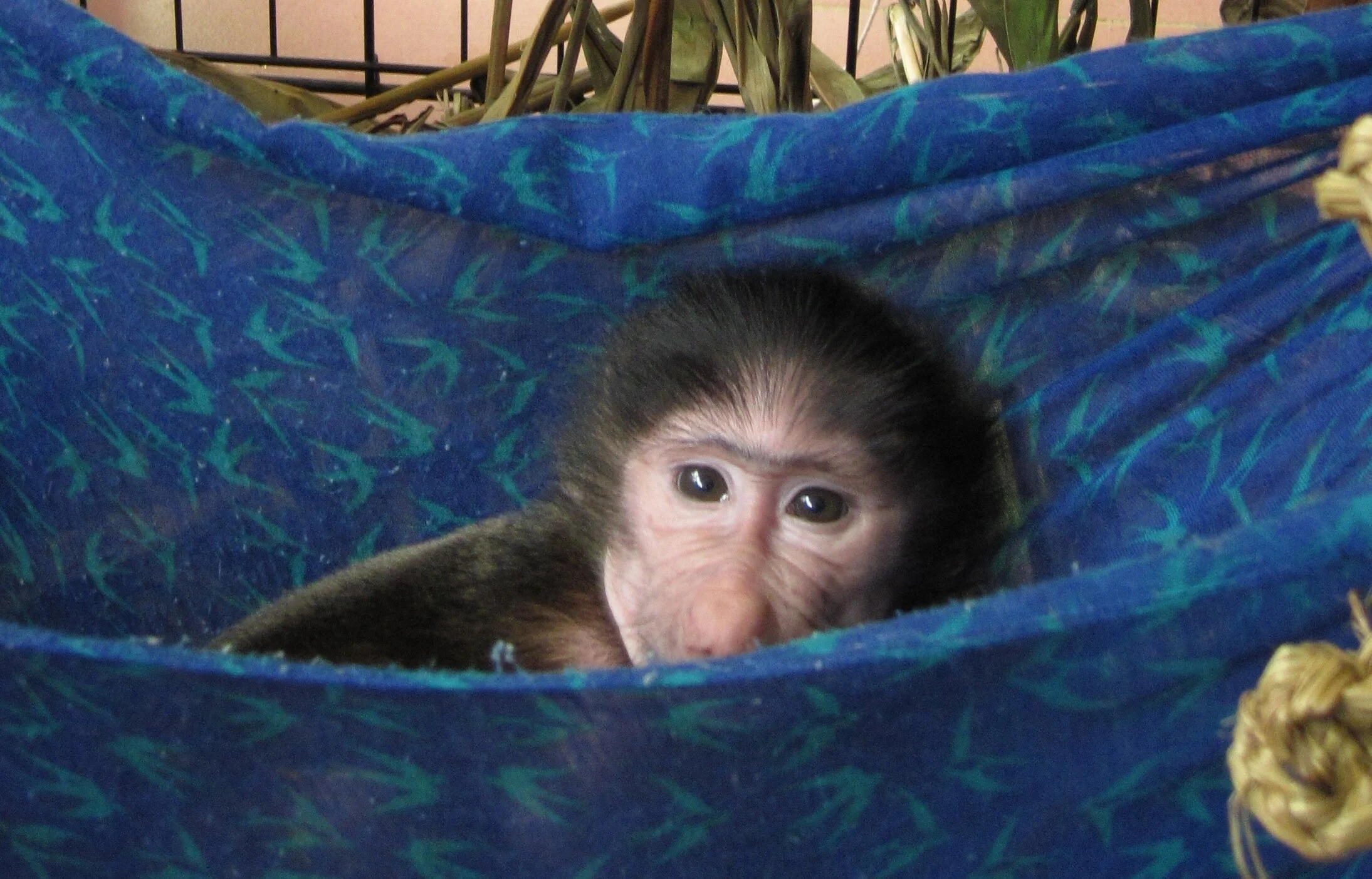The days of Sunshine: Raising an orphaned baboon in Africa
By Robin Huffman, Safina Center Fellow
Sunshine came into my life one January day in 2013. I was volunteering for the fifth time at Ape Action Africa in Cameroon, nestled in Mefou’s secondary-growth forest an hour from Yaounde, the capital. The primate sanctuary harbors orphans of the bushmeat and illegal pet trades.
The sanctuary veterinarian sets a long wooden crate in front of me—my next caregiving assignment. I’m eager but also heartbroken…another primate orphaned, confiscated from wildlife traffickers by the courageous LAGA, the first wildlife law enforcement NGO in Africa.
I open the box. Staring up at me with shiny coal-black eyes is an infant olive baboon, not yet three months old. His face is creamy pink and wrinkled, with perfect heart-shaped nostrils and four teeth. His spiky umber-colored hair is velvety soft as I pick him up. I name him Sunshine. My job as caregiver is to raise him to be healthy, happy, strong, confident and independent, so he can live and thrive with his own kind.
Sunshine as "Kilroy." Photo: Robin Huffman
He will spend three months with me in quarantine, after which he’ll join other sanctuary primates. I settle him in to his daytime home for now, which will make him feel safe and secure—a large cage outfitted with hammocks, fragrant leaves, a mirror, and branches to grip, swing from and perch on. It’ll take Sunshine a while to master them, and it’s endlessly amusing to watch his progress. He is smart and determined. Observing him trying to climb the shelf unit in my room one evening, each attempt is better than the last, until he conquers it and looks at me with an expression I interpret as victorious.
Sunshine spends nights in a large transport cage next to my bed. At first light, like all the sanctuary primates, Sunshine is awake and ready to play. I open his cage and he leaps into my arms or wraps himself around my leg like Velcro. I manage to dress, peeling him off one leg and attaching him to the other while I slip my pants and socks on.
After a bottle, it’s time for breakfast. It’s fascinating watching Sunshine eat—he’s so uncoordinated! He looks competent until he misses his mouth, drops the bit of food I’ve given him and can’t manage to grasp it again.
And in an occasional tantrum, he flings himself into his hammock, just his head peeking out, staring at me indignantly. Other times, in a call he would make to summon his mother, he tilts his head up, lifts his eyebrows, his ears and hair flattening against his head, and with puckered lips, he “moos.” It looks and sounds pitiful…and it’s meant to! That’s usually followed by a sharp convulsive “Aaeenh! Aaeenh!”
Sunshine in his yellow hammock. Photo: Robin Huffman
Sunshine peeking out from his blue hammock. Photo: Robin Huffman
We play throughout the day so he can develop his skills and confidence, interspersed with food and bottles. After dinner, it’s bedtime. My goal is to put him to sleep stress-free. First we chase each other around my room, both of us laughing. Then he climbs. As part of that game, I coax him to hop in and out of his sleeping cage, hoping he’ll get drowsy and stay there. When that doesn’t work, I set him on my foot. He instinctively wraps himself around my ankle. Then I pace, swinging my leg like a pendulum—a carnival ride for Sunshine. It never fails. Fast asleep in minutes. I gently pry him off my leg and ease him into his waiting bed of soft cloths.
Sunshine sleeping, heart shaped nostrils. Photo: Robin Huffman
In the night, I’ll bottle feed Sunshine several times through his cage door. Sometimes, he won’t want to go back to sleep alone, since he’d typically be enveloped by his mother. That’s when I have to muster up some tough love because I’m neither his mother nor a baboon, so it’ll be less traumatic for him in the long run if he doesn’t attach too strongly to me. I poke my fingers through his cage, and Sunshine will fall asleep, either pressed against them or sucking on one, hungry for that innate primal contact.
Next installment, Sunshine meets his first monkey friends, and joins his troop.




